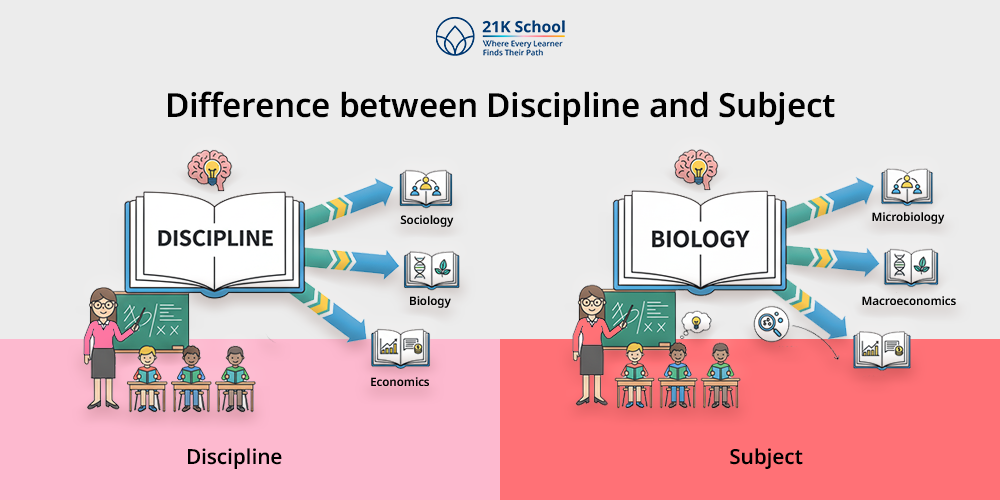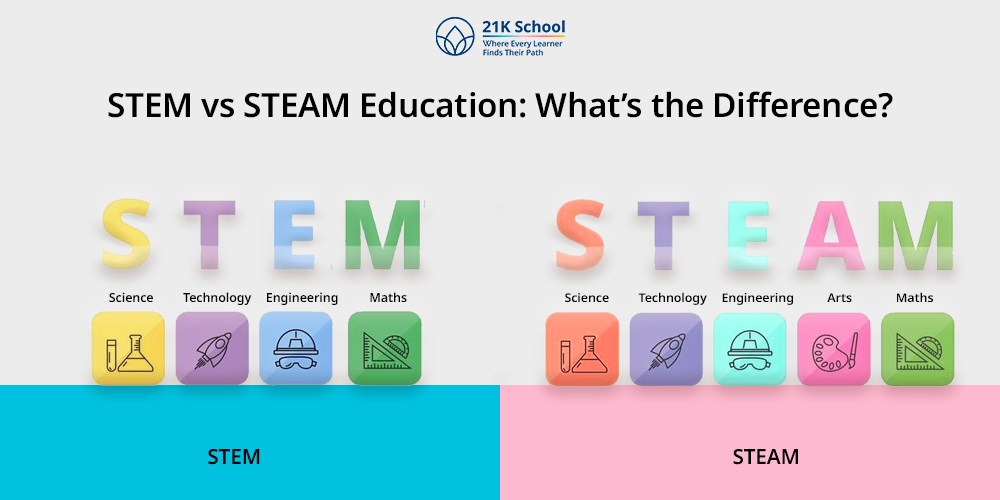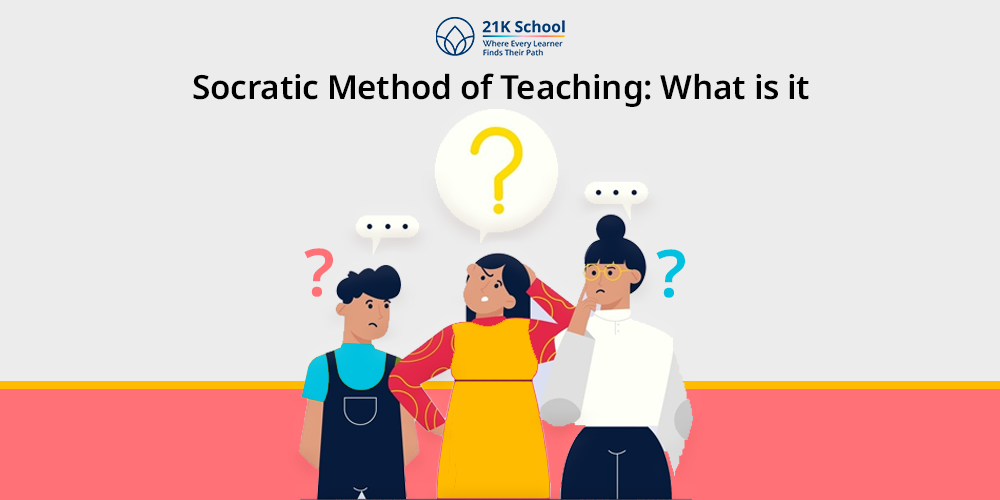
Do you understand the Socratic method of instruction?
A literary approach to education, the Socratic method of teaching is entirely focused on questions or conversation-based lessons.
The Socratic method encourages active learning through conversation-based teaching and learning as opposed to the conventional educational system, which solely concentrates on theoretical knowledge.
The Socratic method emphasises active teaching exclusively as opposed to passive teaching and involves students in the learning process.
Students’ critical thinking skills are known to be strengthened by the Socratic method of instruction, which also lets students pursue their studies independently.
The Socratic method emphasises open-ended questions, which help students gain a deeper understanding of subjects and topics.
The primary goal of the Socratic teaching approach is to offer flexible learning opportunities where teachers serve as facilitators rather than lecturers.
The Socratic method gives equal opportunity to students to engage in the question-based approach of the learning process.
Table of Contents
What is the Socratic Method of Teaching?

The Socratic method of teaching can be defined as a teaching methodology in which classes are taken on the basis of a question-based approach.
In the Socratic method, the main focus was laid on conversations between teacher and student over a class topic.
Unlike traditional aspects of teaching and learning, in which classes are conducted by teachers speaking and students listening. The Socratic method of teaching was first introduced by the ancient Greek philosopher Socrates in 470-399 BCE.
In several of Plato’s works, Socrates and his teacher debate philosophy with an interlocutor or partner.
The Socratic method of teaching is well known for posing open-ended questions that encourage discussion in the classroom rather than providing students with facts and information.
Students are encouraged to participate and are given the chance to pursue lifelong learning through the question-based approach of the Socratic method.
The Socratic method places more emphasis on experiential learning than traditional education, which only stresses rote learning.
How does the Socratic Method of Teaching work?
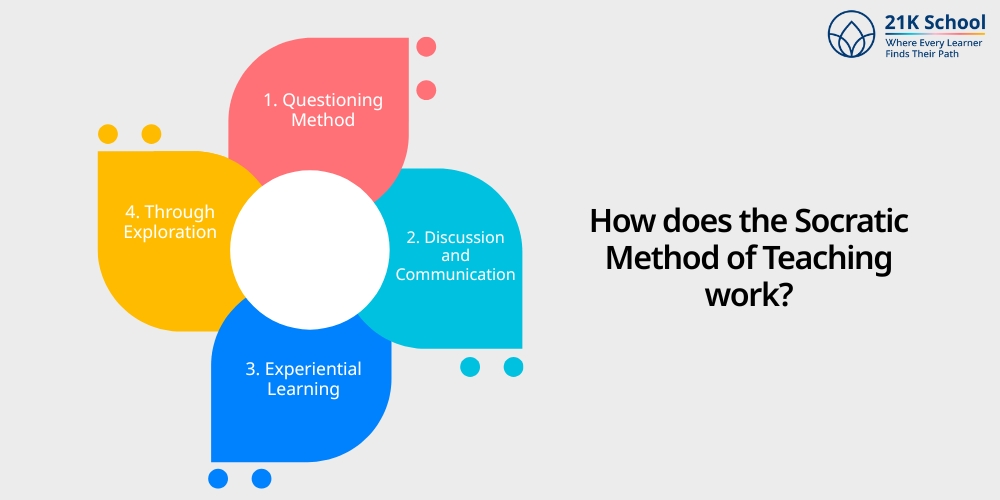
Question-based instruction is a fundamental component of the Socratic method, which aims to promote students’ inquiry-based learning.
The Socratic teaching method is different from the traditional learning approach, which only relies on theoretical knowledge.
This method is known to enhance students’ curiosity and communication abilities. The Socratic method of teaching functions in this way.
1. Questioning Method
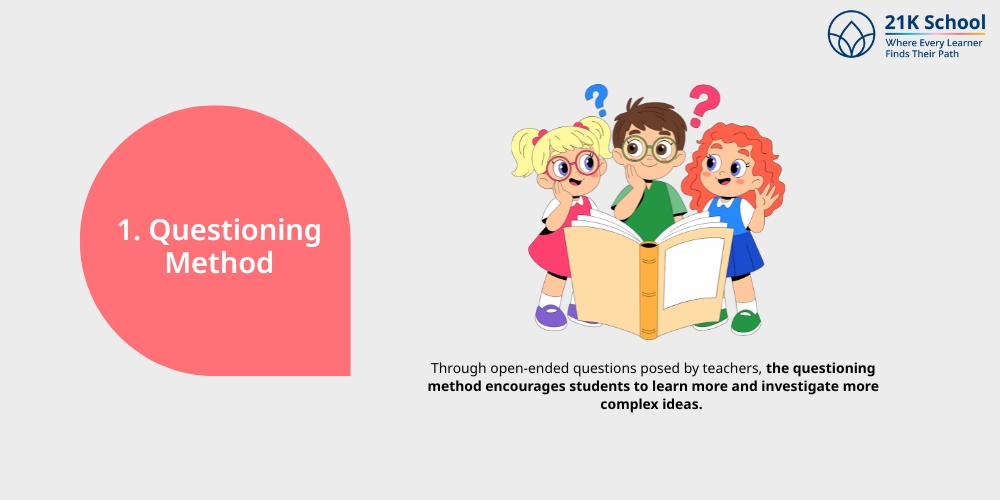
Through open-ended questions posed by teachers, the questioning method encourages students to learn more and investigate more complex ideas.
Students can gain a deeper understanding of the concepts of knowledge comprehension based on their learning abilities by using the questioning method.
Pupils are more likely to acquire creative thinking skills if they learn to ask questions with curiosity.
2. Discussion and Communication

By encouraging dialogue and communication in the classroom, the Socratic teaching approach fosters a collaborative learning environment.
Children are encouraged to actively participate in cooperative learning through the communication approach of the Socratic method of instruction.
By using this approach, students are encouraged to engage in dialogue, listen to others and share knowledge and ideas across the classroom.
3. Experiential Learning
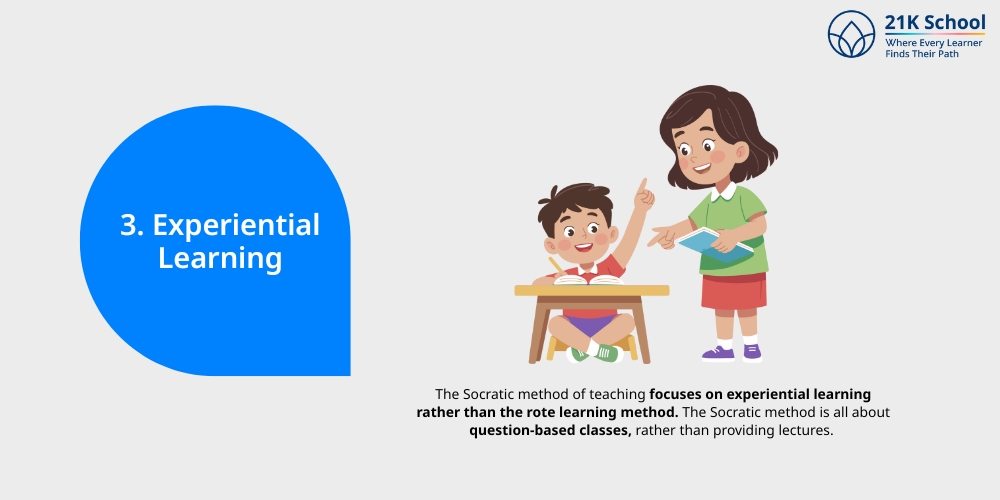
The Socratic method of teaching focuses on experiential learning rather than the rote learning method. The Socratic method is all about question-based classes, rather than providing lectures.
Through this method, students are better able to see challenges as opportunities and develop problem-solving skills. This also allows them to make connections between theoretical aspects and real-world scenarios.
4. Through Exploration
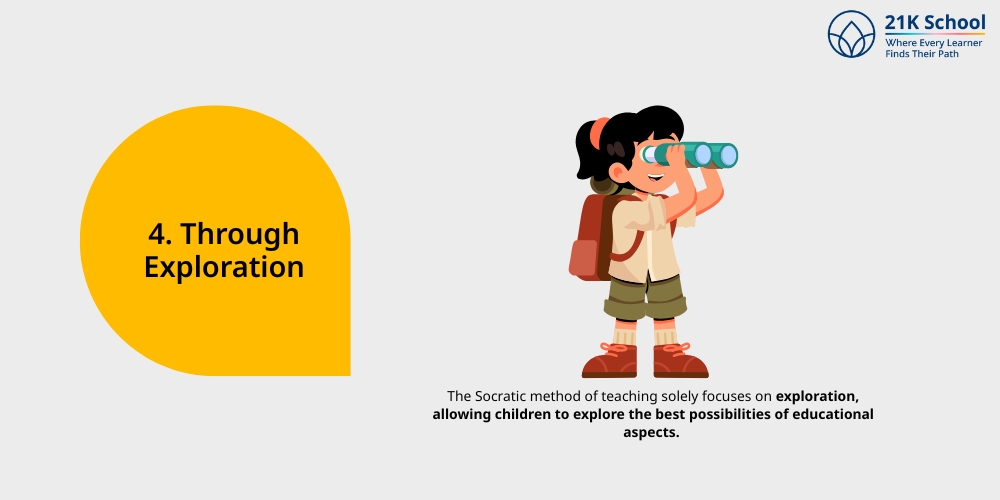
The Socratic method of teaching solely focuses on exploration, allowing children to explore the best possibilities of educational aspects.
The Socratic method allows children to indulge in self-directed research, based on their ideas and concepts, which also allows them to develop curiosity towards learning.
Self-exploration allows children to gain a deeper understanding of concepts and make a correlation between two concepts as well.
Key Aspects of the Socratic Method of Teaching

The key aspect of the Socratic teaching method is solely dependent on the improvement of children’s education by a question-based approach.
This method enables students to grasp deeper knowledge through conversational classes.
This teaching process is known for promoting self-directed learning among children, enabling them to take charge of their own education. The following are the key aspects of the Socratic method of teaching.
1. Promotes STEM Education

The Socratic method of teaching is known for promoting STEM education with the help of inquiry-based learning.
As the Socratic method is completely based on the question-based approach, it allows students to actively engage in the learning process.
The goal of STEM education is to help kids learn how to solve problems. The approach helps kids think more critically, which helps them comprehend difficult scientific and mathematical ideas.
This method widens the scope of educational limits by integrating Science and Maths in subjects in order to improve student engagement.
2. Enhance Collaborative Learning

The Socratic method of teaching also enhances collaborative learning environments by creating discussion-based classes.
Through the Socratic method, every student can share their thoughts, viewpoints and information by means of discussion and debates.
This method enhances collaboration skills among children and enables them to respect and empathise with others.
Through the Socratic method, children are better able to develop communication skills and confidence, which is essential for both academics as well as personal growth.
3. Focuses on Facilitation

The Socratic method mainly focuses on facilitation rather than information provider.
The Socratic method allows teachers to create a positive learning environment through discussion, conversations, one-to-one communication, and so on.
As a facilitator, teachers serve as mentors and support systems for students at every stage of their educational journey.
This approach is also regarded as student-centred learning since it allows students the freedom to conduct their own research and hone their critical thinking abilities.
4. Focus on Prompt Questioning

Prompt questioning is the primary goal of the Socratic teaching approach. Teachers are able to assess students’ performance by using prompt questions that are relevant to the subject matter.
Students’ analytical and critical thinking abilities are also fostered by this approach, which improves their capacity to understand material more precisely.
Through prompt questions after every class, teachers can help students enhance their engagement.
5. Develops Curiosity

The curious nature of the Socratic method encourages people to ask questions and seek answers, which develops love towards learning and gives students the confidence to try new things.
Students’ curiosity and openness grow as they participate in discussions and consider different viewpoints.
Their learning experience is enhanced, and educational equity is advanced as a result of their increased curiosity.
Examples of the Socratic Method of Teaching
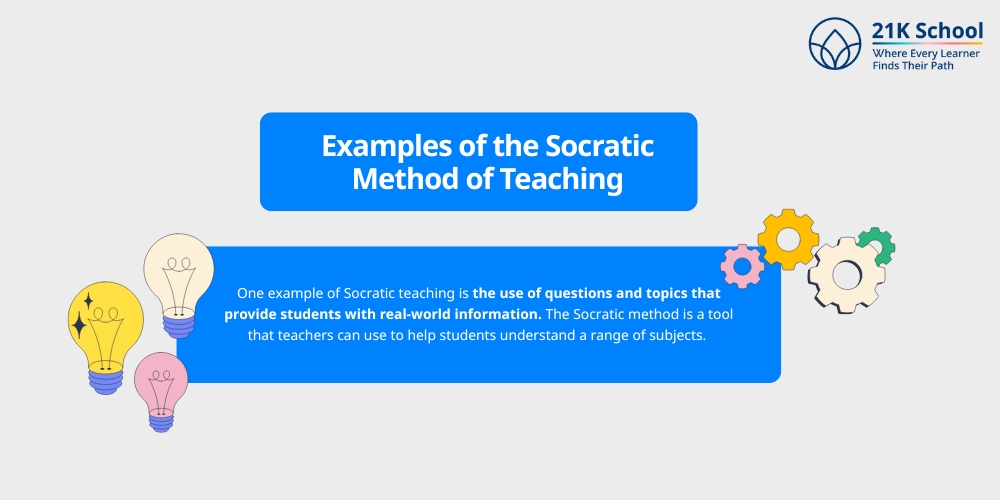
One example of Socratic teaching is the use of questions and topics that provide students with real-world information. The Socratic method is a tool that teachers can use to help students understand a range of subjects.
Students are better able to understand concepts and acquire a deeper understanding of the subjects. Below are examples of Socratic methods of teaching.
- Clarification-Based Question: The example of a clarification-based question is What do you mean when you say letter A?, Could you explain that point further? Can you provide an example?
- Assumption-Based Question: Examples for assumption-based questions can be asked, like Is there a different point of view?, What assumptions are we making here? Are you saying that?
- Reasoning-Based Question: This reasoning-based question focuses on evidence that can be asked as: Is it possible for you to validate the evidence? Do we have all the information we need?
- Implications and Consequences-Based Question: Examples for assumption-based questions can be asked like: How would this affect someone? What are the long-term implications of this?
Advantages of the Socratic Method of Teaching
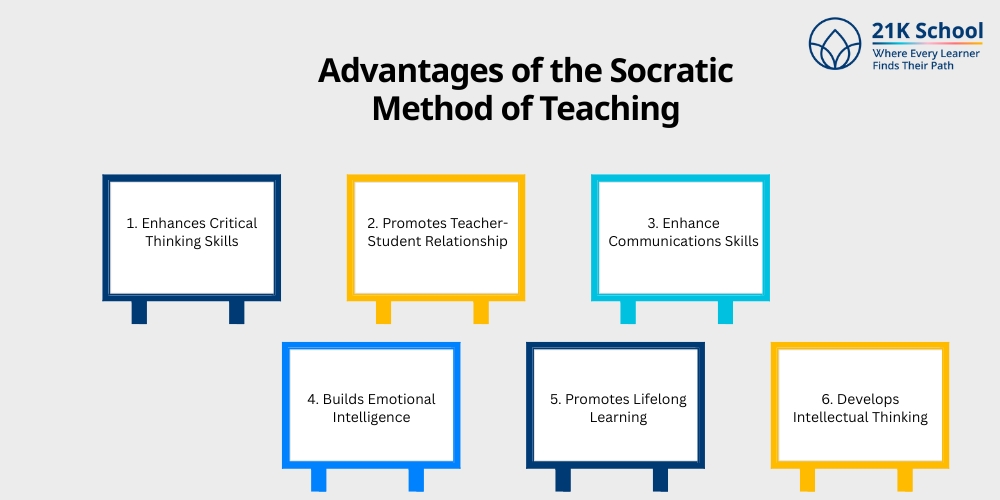
The Socratic teaching method is popular for its question-based approach, which enables children to understand, grasp and integrate knowledge more accurately.
The Socratic method of teaching enhances the cognitive development of children’s enabling them to develop creative thinking skills.
The Socratic method enhances students’ curiosity through the inquiry-based learning approach. The following are the benefits of the Socratic method of teaching.
1. Enhances Critical Thinking Skills
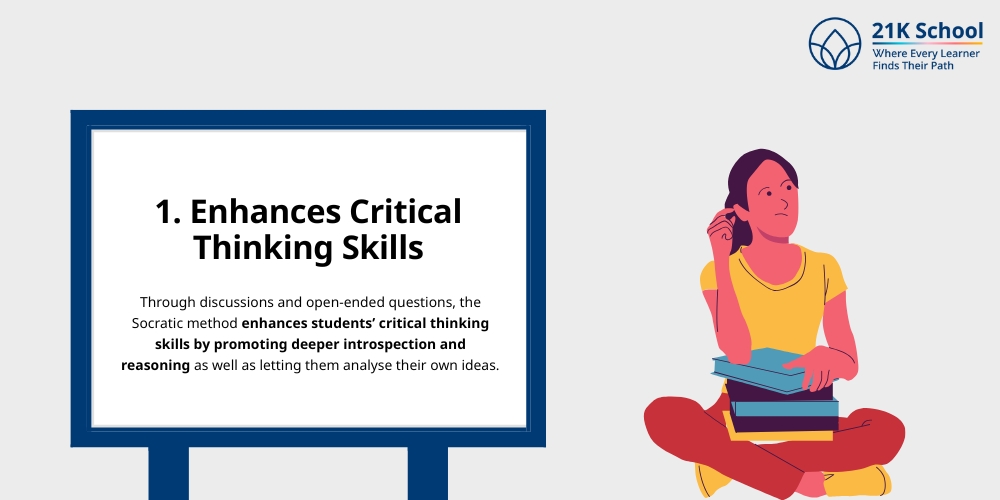
Through discussions and open-ended questions, the Socratic method enhances students’ critical thinking skills by promoting deeper introspection and reasoning as well as letting them analyse their own ideas.
With teachers’ help, students to indulge in skill-based education that enhances critical thinking, which is essential for success in the classroom and profession.
2. Promotes Teacher-Student Relationship

The Socratic method of teaching is known for developing teacher-student relationships, which is essential for cooperative learning.
Through this method, teachers can encourage students to actively participate in the discussion and conversation.
Proper facilitation and guidance from teachers help in setting a dynamic learning environment, which creates trust between the teacher and students, creating a supportive and positive learning environment.
3. Enhance Communications Skills

The question-based approach of the Socratic method of teaching helps in enhancing eye contact communication skills among students.
The Socratic method of teaching employs students to indulge in conversation classes, in which they are better able to communicate with others.
In this method, teachers and students both listen and interpret messages more clearly. This method also enhances their verbal and nonverbal conversation.
4. Builds Emotional Intelligence
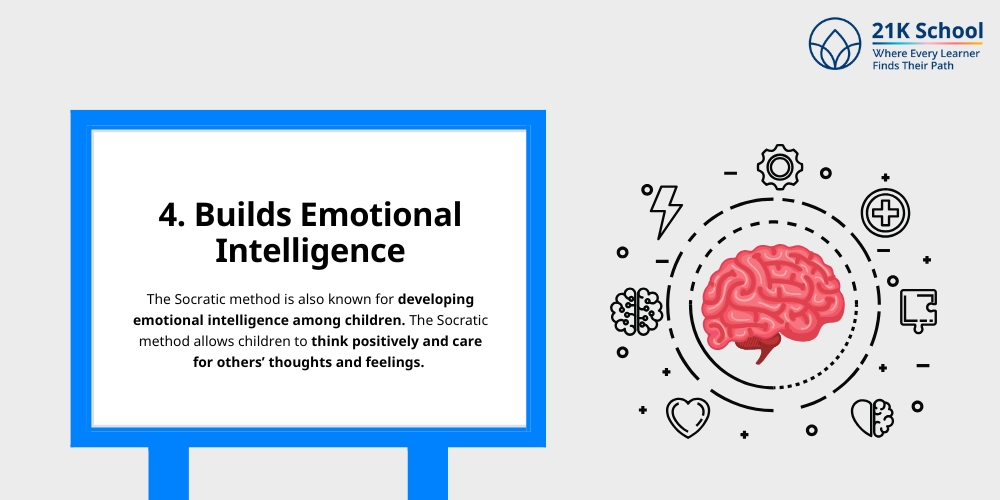
The Socratic method is also known for developing emotional intelligence among children. The Socratic method allows children to think positively and care for others’ thoughts and feelings.
This approach allows children to develop empathy towards others and weigh every aspect of viewpoints, and learn how to handle challenging social situations through discussion and debate.
Emotional intelligence is essential for every part of life, from educational experience to professional growth.
5. Promotes Lifelong Learning
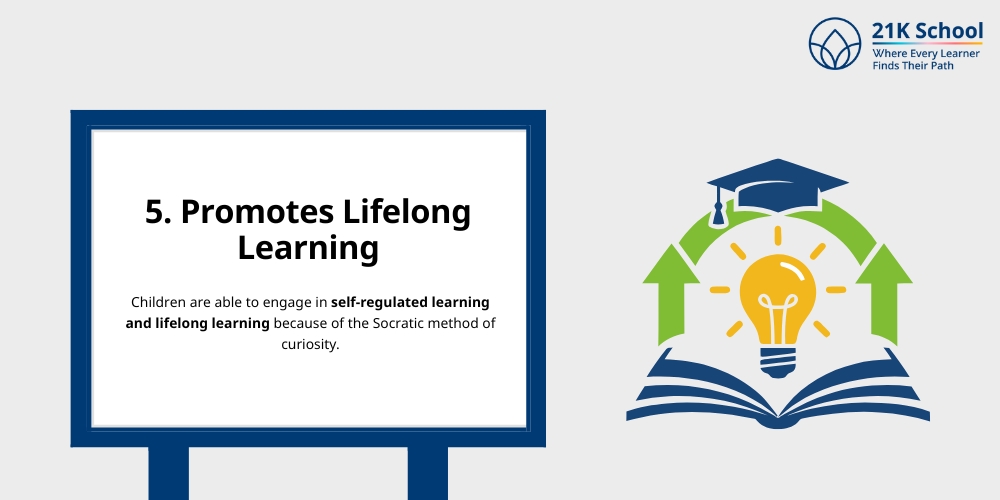
Children are able to engage in self-regulated learning and lifelong learning because of the Socratic method of curiosity.
This approach makes it simple for students to collect data, analyse it and come up with potential solutions to issues.
With this approach to learning, students can cultivate a growth mindset toward learning and view obstacles as opportunities.
6. Develops Intellectual Thinking
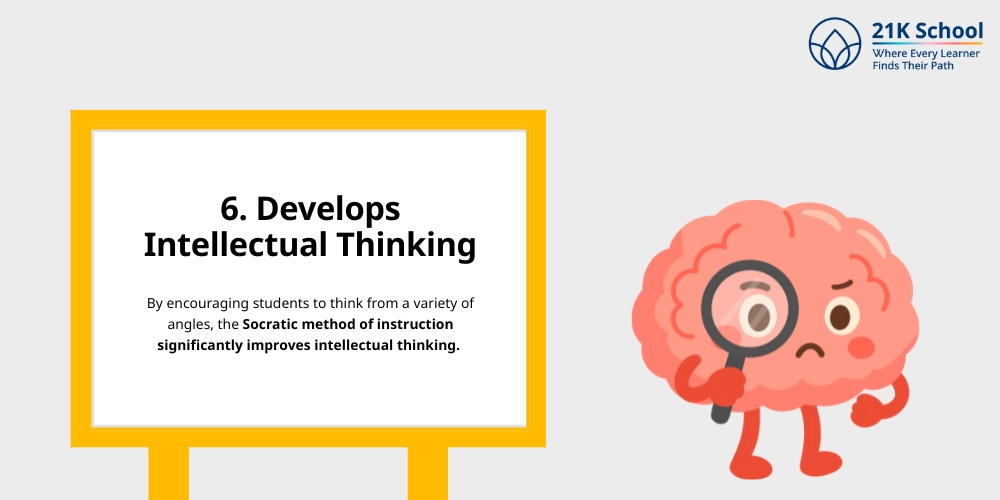
By encouraging students to think from a variety of angles, the Socratic method of instruction significantly improves intellectual thinking.
Students with intellectual thinking skills are able to think critically, participate in group discussions, synthesise information, assess concepts and form their own well-informed opinions.
Disadvantages Socratic Method of Teaching and Effective Solutions
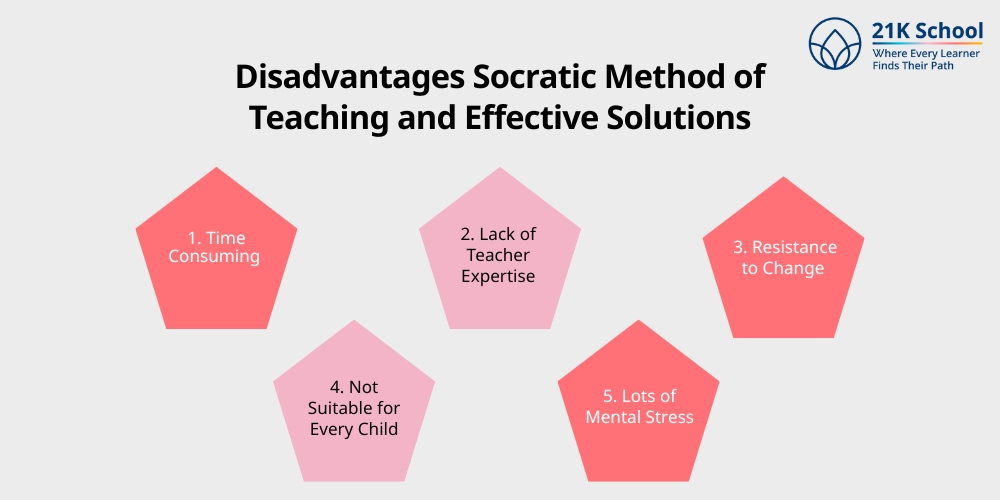
The Socratic method has lots of benefits, but along with the advantages, it has lots of drawbacks.
Students’ ability to understand information is adversely affected by these drawbacks, which also impede the teaching process.
Here you can check the disadvantages of the Socratic method of teaching with effective solutions.
1. Time Consuming

The Socratic method is time-consuming because it depends on question-based discussion. Due to the lengthy process, which makes learning more difficult and decreases student interest, less material is covered.
Solutions to tackle Time Consuming
The problem of time consumption can be solved by an effective study schedule and allocating equal time to every task. This problem can also be avoided by focusing on important questions only, and the rest can be completed through conversations.
This technique helps in the effective allocation of time, through which teachers can shorten their lessons.
2. Lack of Teacher Expertise

One of the biggest obstacles to using the Socratic method of teaching is the lack of teacher expertise. The question-based approach was a major component of the Socratic method, which makes it difficult for many teachers to adopt new strategies.
Educators who have less experience are more likely to make class sessions ineffective, due to which students may also lose interest.
Solution to Tackle the Problem of Teacher Expertise
To tackle the problem of teachers’ expertise, schools can provide special training to teachers. Also, allocating funds to the professional development of teachers with the knowledge they require also helps in promoting the Socratic method.
Even teachers can also attend workshops, seminars, and group projects in order to learn a question-based approach to teaching.
3. Resistance to Change

Resistance to change is a common problem, due to which many children and teachers are unable to adapt to new methods.
As most teachers and students are adapted to traditional schooling methods, switching to a new method will create problems for them. The resistance mainly occurs due to lack of knowledge and discomfort with new methods.
Solution to Overcome Resistance to Change
Small group discussions or the incorporation of Socratic questioning into lessons that have already been taught can be used to gradually introduce students and teachers to this new approach.
4. Not Suitable for Every Child

Every student has their own learning style, and not every student will benefit from the Socratic method of teaching, especially those who do better in the traditional system.
Asking them to think critically on the spot can make some students feel overwhelmed or nervous, which causes students stress.
Solution for overcoming the problem of suitability.
Teachers can use differentiated learning methods by combining the Socratic method with other teaching strategies that take into account different learning styles.
By providing them with multiple opportunities to engage with the material allows students to actively participate in the learning process.
5. Lots of Mental Stress
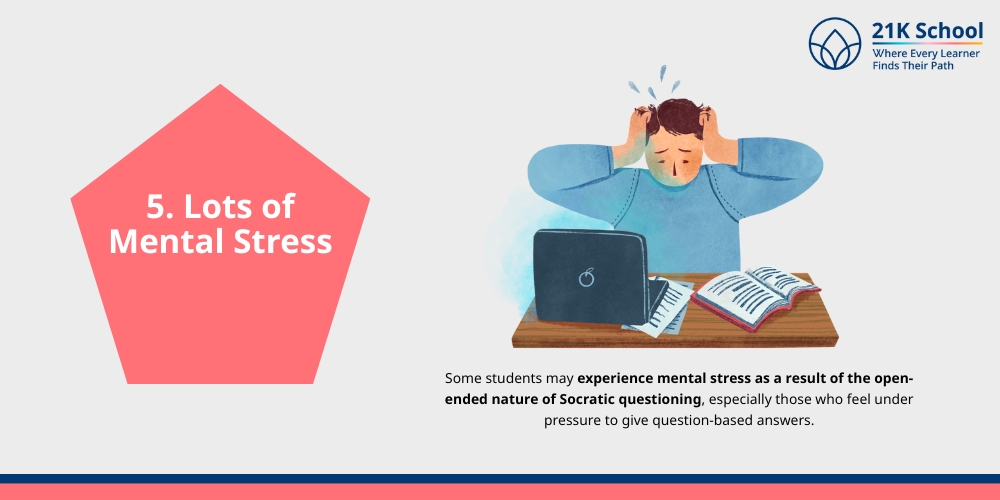
Some students may experience mental stress as a result of the open-ended nature of Socratic questioning, especially those who feel under pressure to give question-based answers.
This pressure causes students to develop study stress as well as fear of exams.
Solution to Tackle Mental Stress
Teachers can alleviate students’ stress by creating a safe, encouraging and positive learning environment that values all contributions regardless of their depth.
Setting objectives, rules, and regulations allows students to study at their own pace.
Wrapping Up
The Socratic Method is known for a dynamic teaching strategy that mainly focuses on a question-based approach of teaching and learning.
Through the use of inquiry-based learning, the Socratic method of teaching enables children to investigate ideas, knowledge and thoughts.
This method allows children to indulge in lifelong learning through exploration.
Although there are many benefits, such as enhancing students’ critical thinking abilities and fostering enduring relationships between educators and students, there are drawbacks as well, such as the time commitment and requirement for certified teachers.


